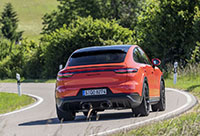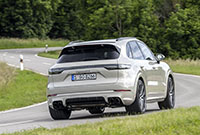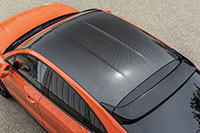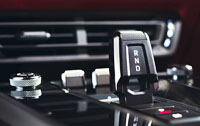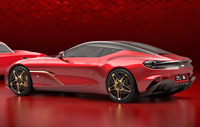
Let’s face it. The current Z car is old. How old? In automotive years, ancient. In fact, it’s oldest design currently being offered in North America. The only older vehicles include a truck and a commercial van, the former being Nissan’s own Frontier and the latter GM’s Chevy/GMC Express/Savana cargo and shuttle vans. This said, there’s new hope on the horizon.
Nissan recently took the wraps off of a new concept car dubbed Z Proto, and while “Proto” obviously stands for prototype, it appears as close to production trim as any fantasy show car the Japanese brand has ever revealed.
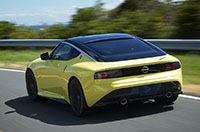
It’s sheet metal actually looks picture perfect for a seventh-generation Z, combining many of the original 240’s design cues with some from the much-loved fourth-generation Z32, while its slick looking interior is as dramatically modern as the current model is as awkward and backwards, yet comes infused with plenty of retro touches.
As is almost always the case, new Z will be larger than the outgoing model is this prototype is anything to go by, with the Z Proto measuring about five and a half inches longer from nose to tail. This doesn’t necessarily mean it will weigh more than the 370’s base 3,232 lb (1,466 kg) curb mass, or lose any of the current car’s driving capability, but more likely due to greater use of modern lightweight materials and the inclusion of a smaller 3.0-litre engine block, down 700 cubic centimeters, will actually weigh less.

The new Z will once again share platform architectures with its pricier Infiniti Q60 cousin, which bodes well for its overall structural integrity and build quality. The new prototype now reaches 4,381 mm (172.5 in) from front to back, which is exactly 141 mm (5.6 in) longer than the current 370Z, but take note it’s actually a fraction of a fraction narrower (1 mm) at 1,849 mm (72.8 in), or identical to the Q60’s width, and 10 mm (0.4 in) lower at 1,310 mm (51.6 in).
The current Z uses a lot of aluminum already, so expect the upcoming version to also use the lightweight alloy for its hood, door skins, and rear liftback, while it will without doubt also utilize aluminum suspension components and an aluminum-alloy front subframe, engine cradle, plus forged aluminum control arms (upper and lower in the rear), steering knuckle, radius rod, and wheel carrier assembly, all found on the current car, which is beyond impressive for its $30,498 base price.

As you may have guessed from the engine noted above, the new Z will feature Nissan/Infiniti’s award-winning twin-turbocharged 3.0-litre VR30DDTT V6, which not only improved on performance, but makes a big difference at the pump over today’s 3.7-litre mill. The current Q60 offers both 300 and 400 horsepower versions, the latter causing many in the industry to dub the next-gen sports car 400Z, but this said it would be a shame not to offer a more affordable variant named 300Z, especially considering the model’s much-loved and sought after 1989–2000 second-generation (Z32) 300ZX. This tact would allow the Z car to be sold in a similar fashion to Porsche’s 911, with various stages of tune from the 300 horsepower 300Z, to a 350 hp 350Z, possibly a 370 hp 370Z and top-line 400Z. Who knows? Maybe there’s a market for a lower-powered $30k Z car to compete head-on with the upcoming redesigned 2022 Toyota 86 and Subaru BRZ. That car will be available with a 2.5-litre H-4 making 228 hp and 184 lb-ft of torque, so 240 hp turbo-four under the hood of a Z car would make a nice rival, wouldn’t it? Can’t imagine what they might call it. I think Nissan would have a lot of fun bringing out special editions of that engine with 20 hp bumps in performance. Of course, we’re only speculating, but hopefully Nissan has something like this in mind as it would be marketing genius (if we don’t say so ourselves).

Of course, rear-biased all-wheel drive will be optional if not standard, and a six-speed manual will probably get the cut in the base car, with at least seven forward gears in the optional automatic version.
The Proto’s interior comes fitted with the manual, incidentally, while anyone familiar with any Z car cabin would immediately know that it’s a modernized version of Nissan’s most revered sports car. Along with trademark giveaways like the trio of dials across the centre dash top and the sloping side windows, not to mention the classic Nissan sport steering wheel with its big stylized “Z” on the hub, this prototype pulls from the current 370Z’s parts bin with respect to the ovoid door handles, their integrated air vents, and the side window defog vents on each corner of its dash. These similarities may end up only being found on this prototype, and used for the sake of expediency and cost cutting, but it is possible Nissan will carry some less critical features such as these forward into the new interior design.
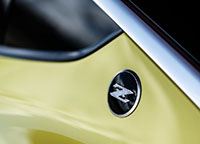
Today’s 370Z is actually quite refined inside, at least in upper trims, with plenty of leather-like, padded, soft-touch surfaces with stitching on the dash, centre console sides and doors, all of which appear to be carried forward into the new concept. It’s likely Nissan will likely upgrade some other areas that are now covered in hard composite, the new car probably featuring more pliable synthetics in key areas that might be touched more often.
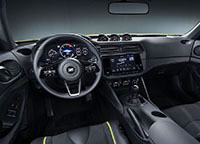
The so far unmentioned elephant in the room (or cabin) is the impressive array of high-definition electronic interfaces, the primary gauges shown being fully digital and very intriguing, plus the centre stack-mounted infotainment touchscreen display appearing amongst the best Nissan currently has on offer. We can expect all the latest tech such as Apple CarPlay and Android Auto smartphone integration, a large rearview camera with potential an overhead, surround-view option, and this being a performance model, sport features such as a lap timer, g-meter, etcetera.
The centre stack also shows a simple triple-dial automatic HVAC interface that oddly doesn’t include dual-zone functionality, so it’s likely this was merely pulled over from the current car and will be updated in the future production Z.
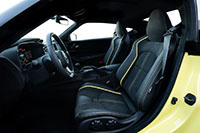
Speaking of today’s 370Z, it can now be had with up to $1,000 in additional incentives, as shown on our 2020 Nissan 370Z Coupe Canada Prices page (or the 2020 Nissan 370Z Roadster Canada Prices page), which is a really good deal considering its aforementioned base price. And before you pick up that phone or drive down to your local Nissan dealership to negotiate, make sure to become a member of CarCostCanada first, so you can access benefits like manufacturer rebate information, updates about various brands’ in-house leasing and financing deals, plus of course dealer invoice pricing that could keep thousands in your pocket. Find out how our CarCostCanada system works, and make sure to download our free CarCostCanada app from the Google Play Store or Apple Store, so you can have all of this critical info with you when you need it most, at the dealership.
Lastly, be sure to watch Nissan’s trio of Z Proto videos below, because if this concept is anything to go by, we’re in for a real treat when the production model arrives.
Unleash the #PowerOfZ (2:18):
Hear the Z Proto roar (0:33):
Get ready for the Nissan Z Proto (0:29):
Photo credits: Nissan


